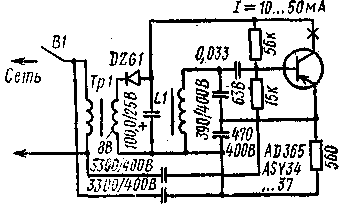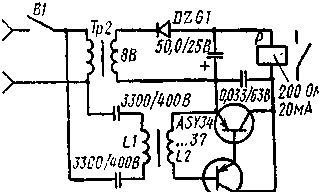Home telemechanics on a network of 220 volts. Encyclopedia of radio electronics and electrical engineering

Encyclopedia of radio electronics and electrical engineering / Electronics in everyday life
 Comments on the article
Comments on the article
The device shown in the diagrams allows you to send control signals through the in-house AC lighting network. From the home control panel, you can turn on and off various household electrical and radio appliances, open the front door or garage gate, etc. The control panel can be both stationary and portable. The transmitter and receiver are connected to the AC mains sockets inside the apartment.
Operating principle is explained in Fig. 1. The frequency of the control signals is selected within 1...10 or 60...140 kHz.

Fig. 1
The higher the control frequency, the stronger the harmful effect of the capacitance and inductance of the wiring. It is not allowed for transmitter signals to penetrate outside the apartment (house). In order not to violate the rules, appropriate chokes and filters are included in the network. Experience has shown that with a control frequency of 1 ... 2 kHz, the role of an anti-interference filter is played by an apartment electric meter. There is no interference with radio or television reception.
Do not use control signals with a frequency exceeding 100 kHz. It should also be added that the less the home electrical network is loaded, the better the operating conditions of the control device.
Transmitter (Fig. 2) is a transistor self-oscillator. Coil L1 has 500 turns of PEV or PEL 0,1 wire and is wound on a ferrite rod from a magnetic antenna with a diameter of 8 ... 10 and a length of 50 ... 100 mm. Tr1 - ringing or incandescent transformer; B1 - call button.

Fig. 2
Coils L1, L2 receiver (Fig. 3) contain 200 turns of PEV 0,1 wire and are wound on an armored ferrite core with a diameter of 18 and a height of 11 mm or 500 turns of the same wire, but wound on a ferrite rod from a magnetic antenna (6 ... 10 X 50...100 mm); Tr2 - ringing transformer; Relay P has contacts capable of interrupting a power of 50 W.

Fig. 3
The case of both devices with dimensions of 50x100x150 mm is made of plastic and shielded.
By adding resonant circuits, you can get a multi-channel device. As transistors, you can use any low-power silicon transistors of direct conduction, for example, KT361.
Publication: cxem.net
 See other articles Section Electronics in everyday life.
See other articles Section Electronics in everyday life.
 Read and write useful comments on this article.
Read and write useful comments on this article.
<< Back
 Latest news of science and technology, new electronics:
Latest news of science and technology, new electronics:
Machine for thinning flowers in gardens
02.05.2024
In modern agriculture, technological progress is developing aimed at increasing the efficiency of plant care processes. The innovative Florix flower thinning machine was presented in Italy, designed to optimize the harvesting stage. This tool is equipped with mobile arms, allowing it to be easily adapted to the needs of the garden. The operator can adjust the speed of the thin wires by controlling them from the tractor cab using a joystick. This approach significantly increases the efficiency of the flower thinning process, providing the possibility of individual adjustment to the specific conditions of the garden, as well as the variety and type of fruit grown in it. After testing the Florix machine for two years on various types of fruit, the results were very encouraging. Farmers such as Filiberto Montanari, who has used a Florix machine for several years, have reported a significant reduction in the time and labor required to thin flowers.
... >>
Advanced Infrared Microscope
02.05.2024
Microscopes play an important role in scientific research, allowing scientists to delve into structures and processes invisible to the eye. However, various microscopy methods have their limitations, and among them was the limitation of resolution when using the infrared range. But the latest achievements of Japanese researchers from the University of Tokyo open up new prospects for studying the microworld. Scientists from the University of Tokyo have unveiled a new microscope that will revolutionize the capabilities of infrared microscopy. This advanced instrument allows you to see the internal structures of living bacteria with amazing clarity on the nanometer scale. Typically, mid-infrared microscopes are limited by low resolution, but the latest development from Japanese researchers overcomes these limitations. According to scientists, the developed microscope allows creating images with a resolution of up to 120 nanometers, which is 30 times higher than the resolution of traditional microscopes. ... >>
Air trap for insects
01.05.2024
Agriculture is one of the key sectors of the economy, and pest control is an integral part of this process. A team of scientists from the Indian Council of Agricultural Research-Central Potato Research Institute (ICAR-CPRI), Shimla, has come up with an innovative solution to this problem - a wind-powered insect air trap. This device addresses the shortcomings of traditional pest control methods by providing real-time insect population data. The trap is powered entirely by wind energy, making it an environmentally friendly solution that requires no power. Its unique design allows monitoring of both harmful and beneficial insects, providing a complete overview of the population in any agricultural area. “By assessing target pests at the right time, we can take necessary measures to control both pests and diseases,” says Kapil ... >>
 Random news from the Archive Random news from the Archive Self-healing glass
15.12.2017
A group of Japanese researchers created a special glass that has the ability to self-heal if its integrity is violated. During the development of a new type of adhesive type, a material was created that can be easily restored after a breakdown.
Researchers at the University of Tokyo, in the course of their experiments to create a special adhesive agent, managed to make a material that resembles ordinary glass in all characteristics. The main feature of the created novelty is that if the parts of the glass formed from its breaking are applied to each other along the junction where the split occurred, then they will rejoin each other.
Scientists argue that the former strength of this material in case of violation of its integrity can be easily restored by holding the broken parts in contact with each other for several hours.
The scientists called this invention "polythiourea", and according to their assurances, the new material can soon replace the usual fragile glass, which is thrown away immediately after losing its integrity.
|
 Other interesting news:
Other interesting news:
▪ Sony's high-speed 4K sensor
▪ Li-Pol batteries EEMB with increased discharge current
▪ Artificial muscle based on natural proteins
▪ Music from the machine
▪ Created spider silk using photosynthetic bacteria
 News feed of science and technology, new electronics
News feed of science and technology, new electronics
 Interesting materials of the Free Technical Library:
Interesting materials of the Free Technical Library:
▪ site section Voltage converters, rectifiers, inverters. Article selection
▪ article How to drink to give. Popular expression
▪ Why Do Comets Disappear? Detailed answer
▪ Svidin's article. Legends, cultivation, methods of application
▪ article Simple metal detector. Encyclopedia of radio electronics and electrical engineering
▪ article The indicator of listening to a conversation on a parallel phone. Encyclopedia of radio electronics and electrical engineering
 Leave your comment on this article:
Leave your comment on this article:
Comments on the article:
Eugene
Good outline.
 All languages of this page
All languages of this page
Home page | Library | Articles | Website map | Site Reviews

www.diagram.com.ua
2000-2024







 Arabic
Arabic Bengali
Bengali Chinese
Chinese English
English French
French German
German Hebrew
Hebrew Hindi
Hindi Italian
Italian Japanese
Japanese Korean
Korean Malay
Malay Polish
Polish Portuguese
Portuguese Spanish
Spanish Turkish
Turkish Ukrainian
Ukrainian Vietnamese
Vietnamese



 Leave your comment on this article:
Leave your comment on this article: